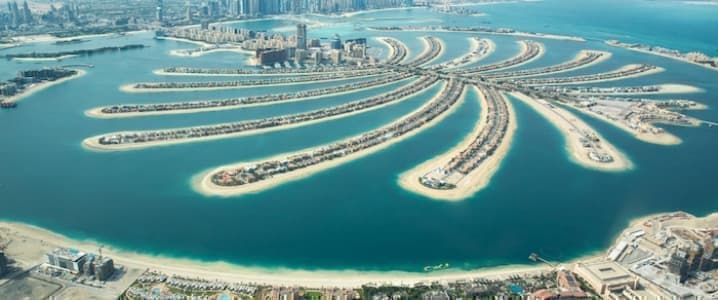Milking cows at sea is only the beginning of what is fast becoming our Waterworld future. The bulk of our next-generation agriculture and energy is destined to be seaborne.
With 70 percent of the Earth’s surface covered with water, it was only a matter of time—and population growth—before we began using this water for more than just fishing and transport. While we are still far from a Waterworld scenario, the number of inventions with “floating” in front of them is growing. And the latest invention that literally walks on water is something you might never expect.
Floating wind farms are already an ordinary sight in some parts of the world. So are floating solar farms. The biggest one in Europe just started operating in France earlier this month.
But now, the world is welcoming floating farms 2.0: the floating dairy farm—a world-first—in the Netherlands.
The aptly named Floating Farm has three levels, covering everything from feeding and rest for the cows to milking, manure and milk processing, and a store for the produce, complete with a visitor’s entrance. Almost every daily chore on this floating farm is automated, making it even more cutting-edge.
The energy supply is renewable, too, coming from a floating solar array, and the roof is designed as a rainwater collector. There is only one concession to the fact that cows are not, after all, amphibious: They have access to a land-based pasture onshore.
“The amount of arable land is decreasing and the world population is growing so how can we produce enough healthy food in the future?” says Minke van Wingerden, who developed the farm with her partner, Peter. She adds the idea came from Hurricane Sandy, which hit the States in 2012 while Peter was in New York.
Related: Floating Nuclear Power: Chernobyl On Ice Or The Future Of Energy?
The flooding was so bad, fresh food disappeared from New York stores in just two days, giving Minke and Peter the idea of producing locally, on the water, where there is no danger of, well, floods.
And it’s not just flood danger that disappears with floating farms. The amount of arable land globally is less than 40 percent, and the world’s population is growing fast. By 2050, it is forecast to reach 9.8 billion. Meanwhile, agricultural land, which includes both arable land and land with crops already grown on it, makes up 37.4 percent of the planet’s total land area.
Truth be told, this is more than what we had in the early 1960s, when agricultural land was less than 36 percent, but not a lot more. With a fast-growing population, chances are it will at some point start declining unless, of course, someone decides to completely deforest the planet to make space for cities—hardly a possibility even for the most headstrong climate change skeptics.
So, with this sort of trend on the way, utilizing the 70 percent of water that cover the Earth’s surface makes perfect sense. In fact, floating farms are not a new discovery. In Bangladesh, people used to grow vegetables in the water a hundred years ago. Now, they have revived this method of agriculture and the results are rather promising.
Flood-proof, self-sufficient in energy, environmentally friendly: what’s not to like about floating farms? Well, it seems that getting them from concept to commercialization takes quite a while.
The Rotterdam Floating Farm is not the only project that seeks to combine the benefits of nature with the ingenuity of humankind. A Spanish company, Forward Thinking Architecture, also has a floating farm project, but it has yet to build it.
The Smart Floating Farms concept touches all bases. It has three levels that can accommodate rainwater collectors, solar panels—or micro wind farms or wave energy converters—and greenhouses where plants are grown hydroponically. This means they are grown in a water solution rather than soil, with no seasonal limitations to crops. The concept farm also includes a fish farm.
According to Forward Thinking Architecture, the farm, which is modular, by the way, making it flexible for deployment, could produce 8,000 tons of vegetables annually. Related: Oil Production Paralyzed As Venezuela's Electricity Crisis Worsens
That’s certainly an impressive number, so why isn’t it built yet? Perhaps, while a great concept, turning that into a real facility is on the costly side.
Yet another floating project suggests costs may sooner or later fall enough to make more of these farms a reality. The Oceanix City project, developed with the support of the UN Human Settlement program, features clusters of islands that while not just farms, would be self-sufficient in terms of food and water.
Sooner or later, some parts of the world will have no choice but to take to the water to grow their food. Cities expand and people leave farmlands for the city where there are more job opportunities. At the same time, demand for food is growing with the global population. Urban farming is a hot concept. Floating farming is likely to start getting hotter, too, especially in areas threatened by coastline erosion and a rising risk of flooding.
That’s one thing we can all do about climate change: prepare for its effects rather than complain about its causes without offering a solution to the problem. Advanced construction technology—think modular building of everything—and low-cost renewable energy are two of the tools in the toolbox that will build our future farms.
Add hydroponics and all you’d need would be some seeds. And water. Lots of water.
By Irina Slav for Oilprice.com
More Top Reads From Oilprice.com:
- IEA: An Oil Glut Is Looming
- Protect The Oil: Trump’s Top Priority In The Middle East
- Why The Latest Keystone Spill Is Disastrous For Canadian Oil


















